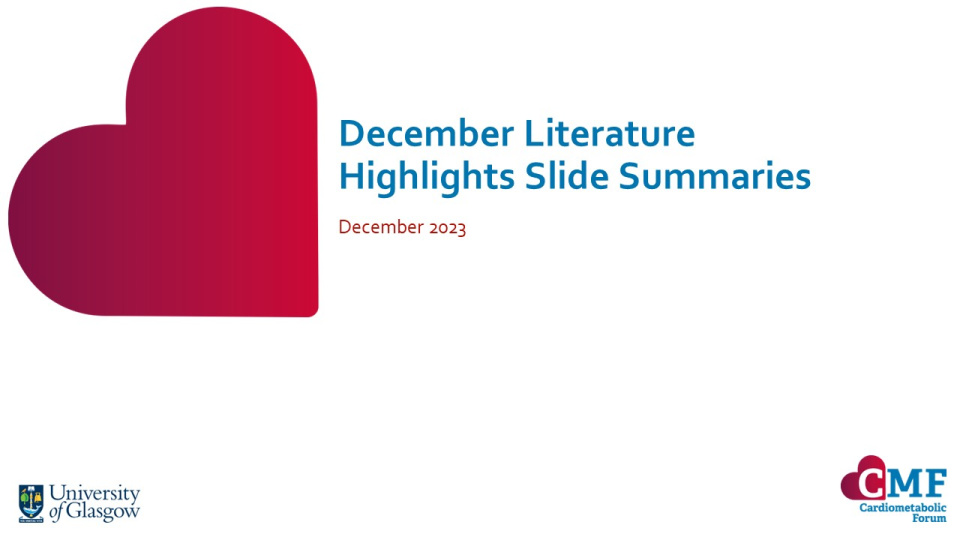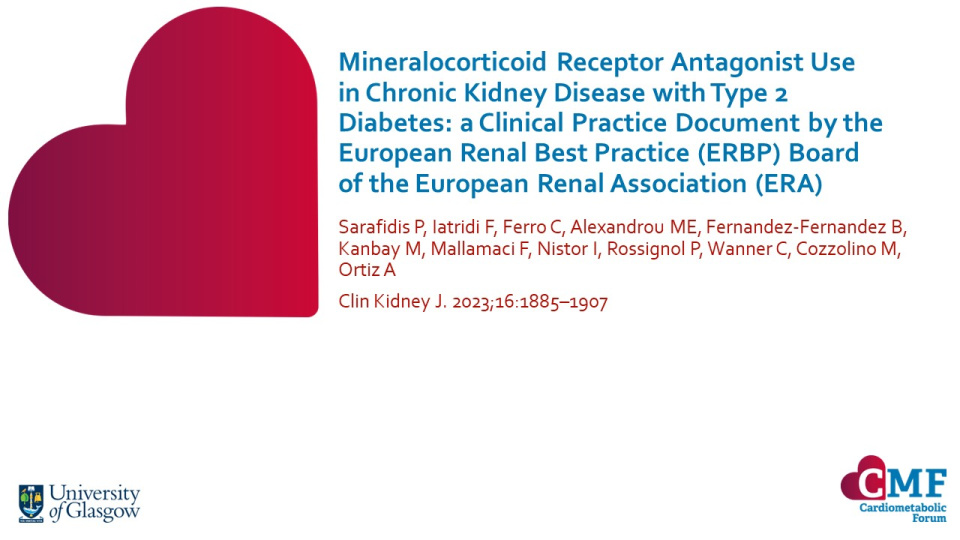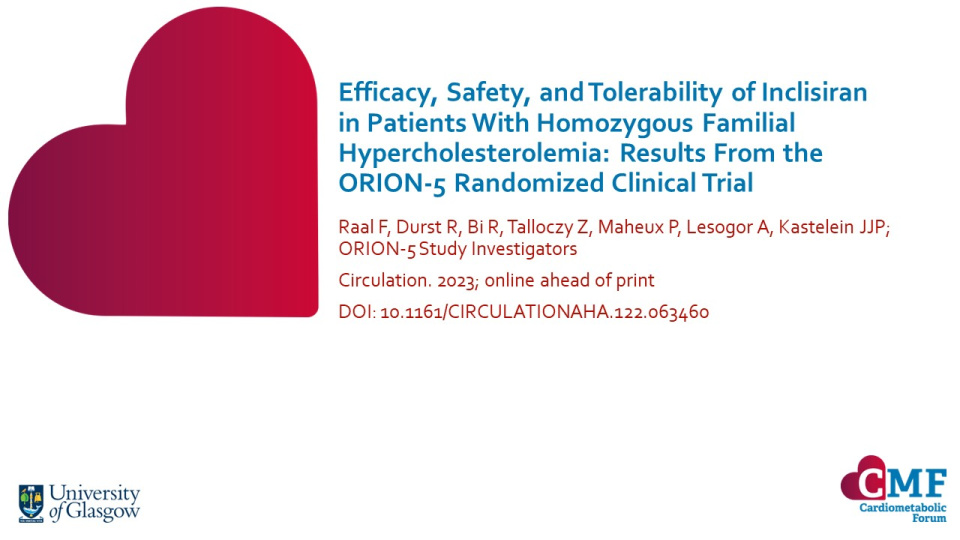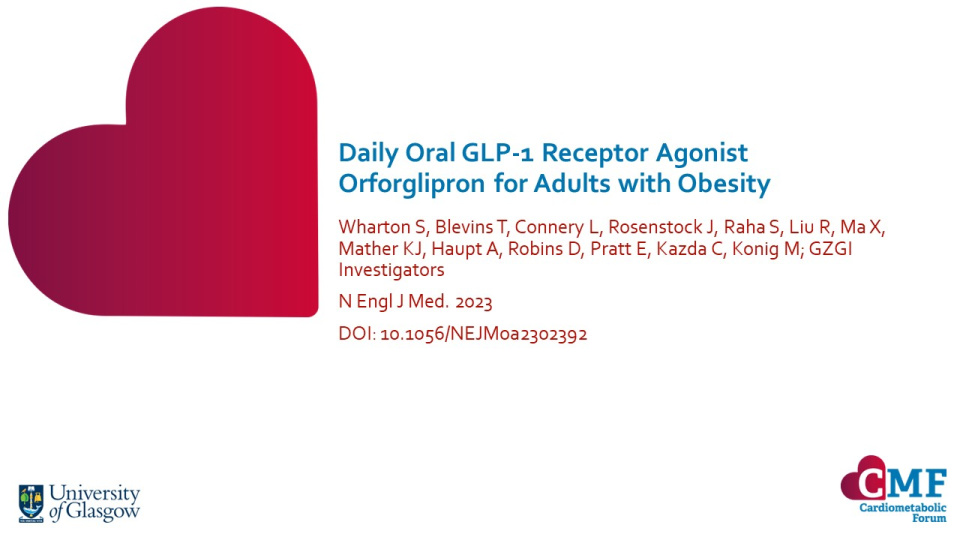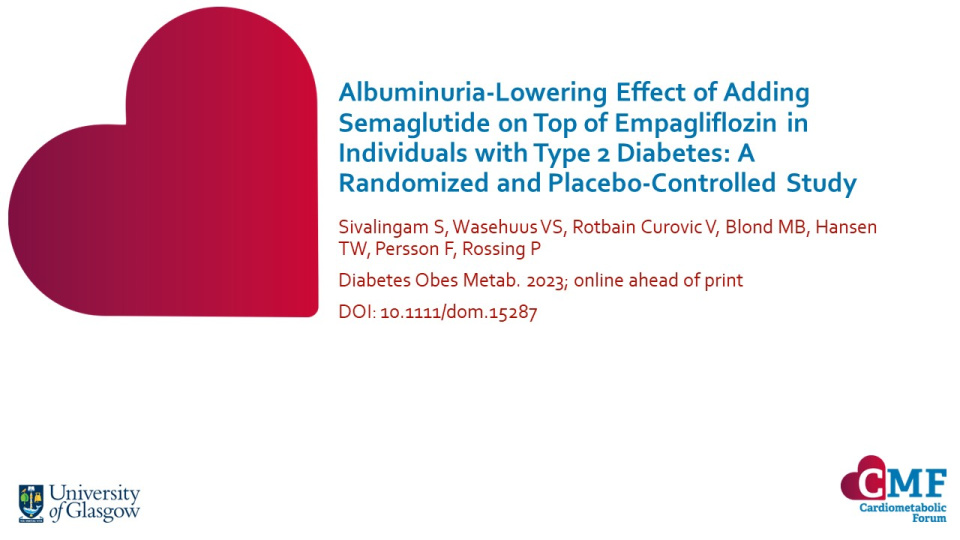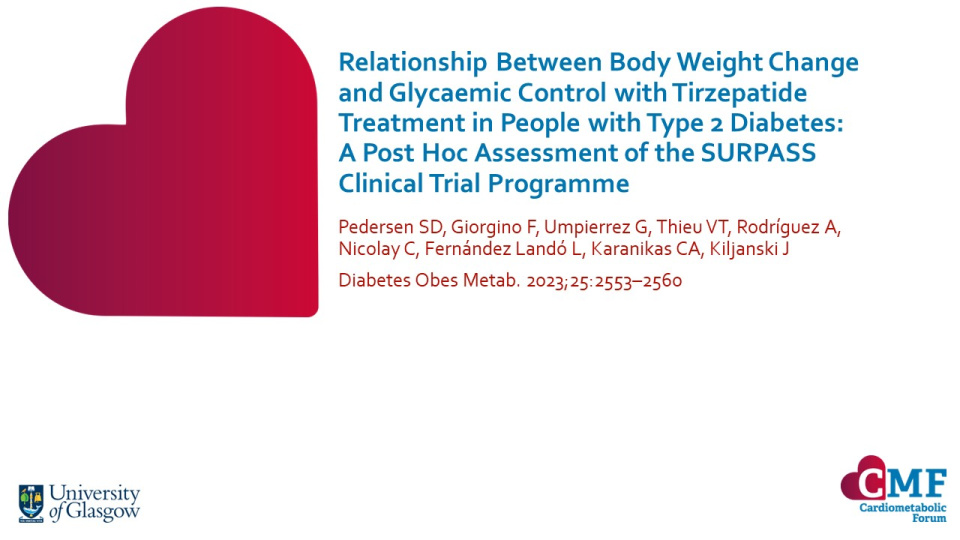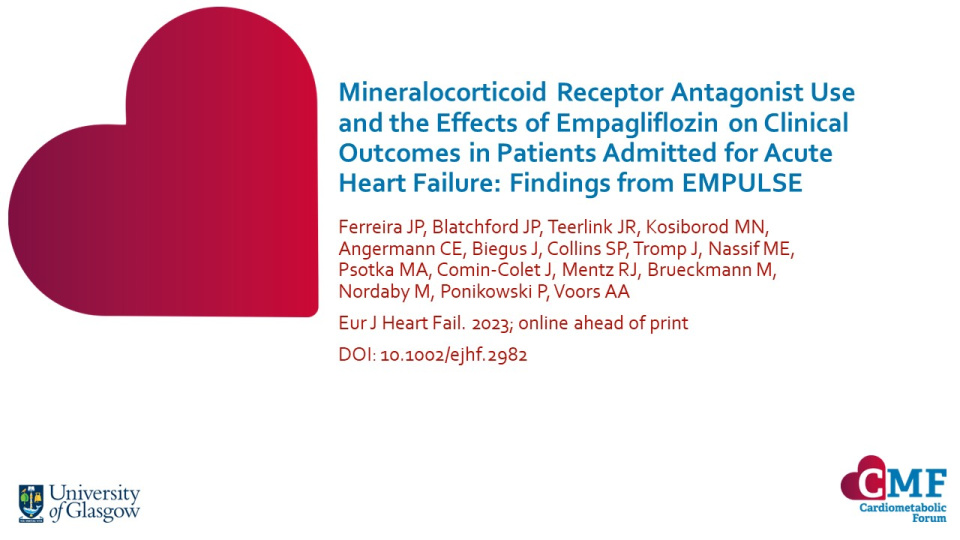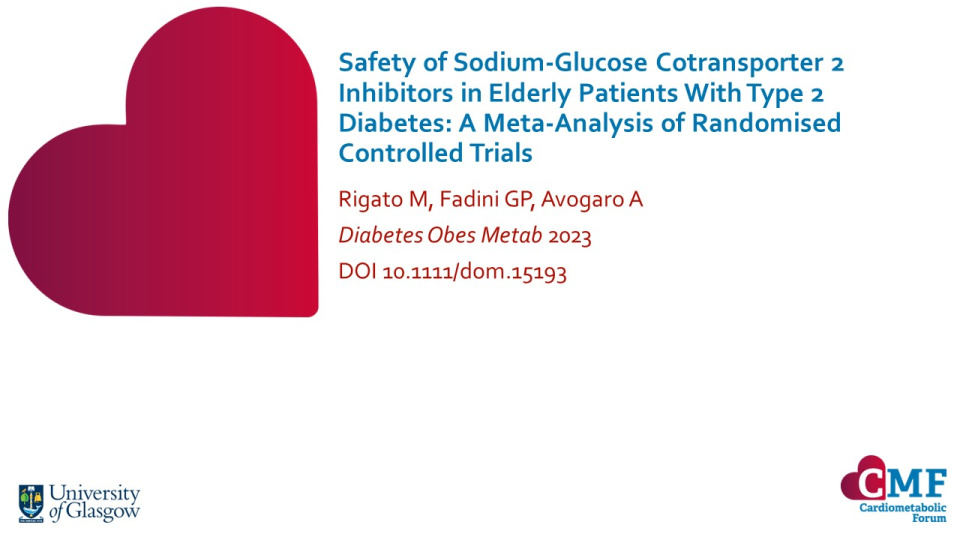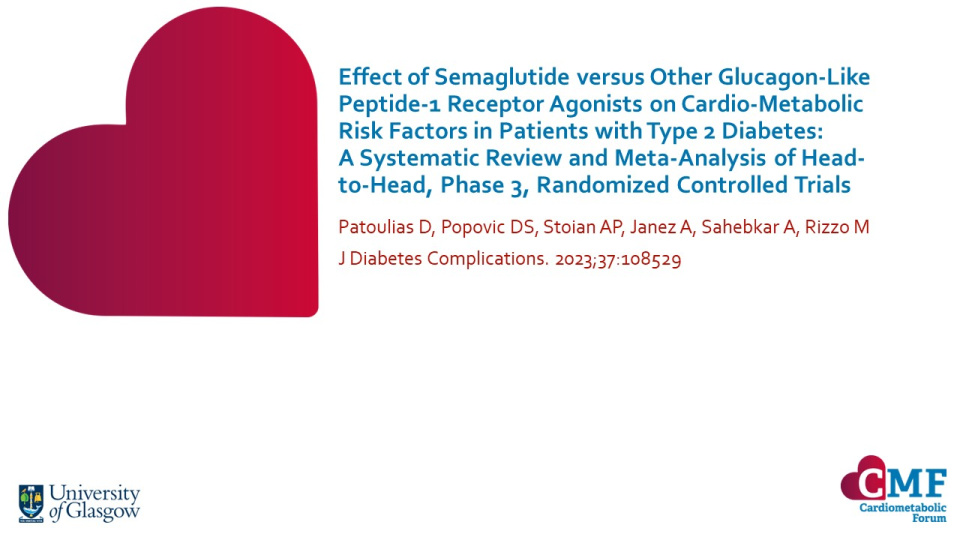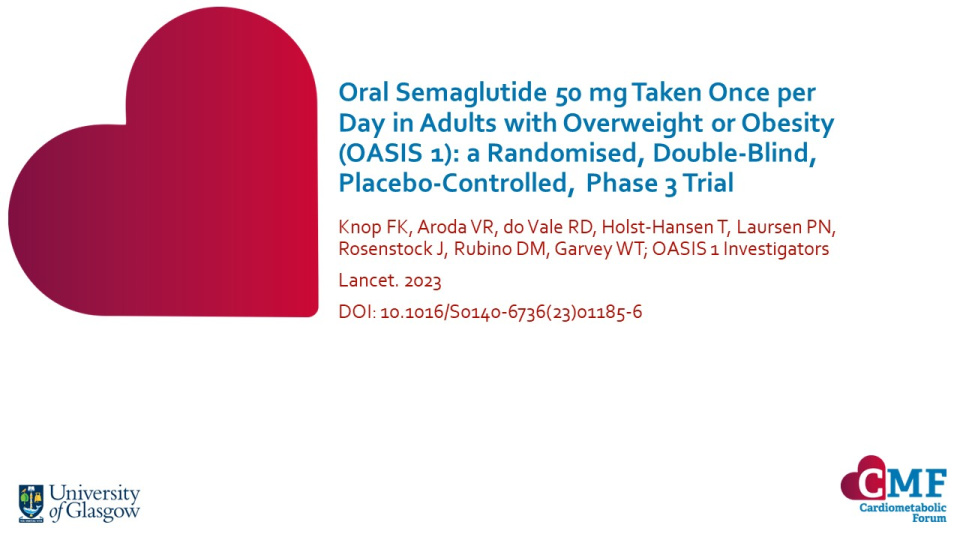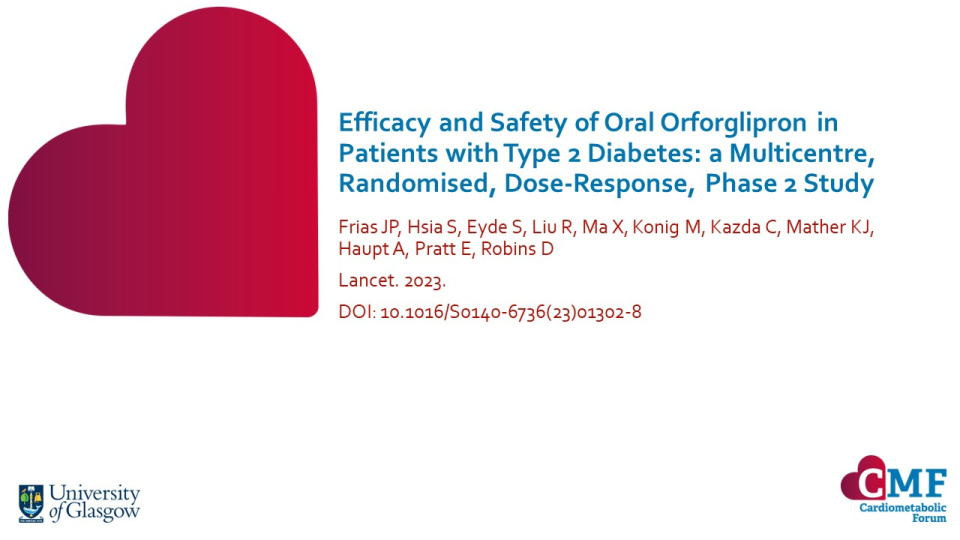Publications
Stay up to date with our literature reviews which are curated by experts to feature the most important publications released each month. Explore our publications for access to concise summary slides for your own use.
Mineralocorticoid Receptor Antagonist Use in Chronic Kidney Disease with Type 2 Diabetes: A Clinical Practice Document by the European Renal Best Practice (ERBP) Board of the European Renal Association (ERA)
Clin Kidney J. 2023;16:1885–1907
Patients with CKD and T2D are at high risk of both developing kidney failure and of CV events. With RAS blockers, residual risk of CKD progression remains high and no significant reduction in CV events and mortality has been seen in major studies in patients with CKD and T2D. Steroidal MRAs have been shown to reduce albuminuria in individuals on RAS monotherapy, but widespread clinical use is limited by the risk of hyperkalaemia and the absence of trials with hard renal outcomes. In recent years, non-steroidal MRAs have received increasing interest due to their better pharmacological profile, particularly finerenone, which effectively reduced CKD progression and CV outcomes in participants with T2D in Phase 3 trials.
Keywords:
Efficacy, Safety, and Tolerability of Inclisiran in Patients With Homozygous Familial Hypercholesterolemia: Results From the ORION-5 Randomized Clinical Trial
Circulation. 2023; online ahead of print DOI: 10.1161/CIRCULATIONAHA.122.063460
A proof-of-concept trial showed that inclisiran, a small interfering RNA that prevents production of the hepatic PCSK9 protein, could lead to durable reductions in LDL-C levels when added to statins and ezetimibe in 3 out of 4 patients with homozygous familial hypercholesterolaemia (HoFH).
Keywords:
Daily Oral GLP-1 Receptor Agonist Orforglipron for Adults with Obesity
N Engl J Med. 2023; DOI: 10.1056/NEJMoa2302392
Orforglipron is a once-daily oral nonpeptide GLP-1RA in development for weight management and the treatment of T2D. This phase 2 double-blind trial evaluated the efficacy and safety of orforglipron in adults with obesity, or with overweight plus at least one weight-related coexisting condition, and without T2D. In total, 272 participants were randomised to orforglipron (12, 24, 36 or 45 mg) or placebo once daily for 36 weeks, with a primary endpoint of change from baseline in body weight at week 26.
Keywords:
Albuminuria-Lowering Effect of Adding Semaglutide on Top of Empagliflozin in Individuals with Type 2 Diabetes: A Randomized and Placebo-Controlled Study
Diabetes Obes Metab. 2023; online ahead of print DOI: 10.1111/dom.15287
The proposed different mechanisms of SGLT2i and GLP-1RAs indicate that combination therapy may have additive or synergistic effects on the kidneys. This placebo-controlled, double-blind, parallel-group study investigated the effect on albuminuria of adding semaglutide to ongoing treatment with empagliflozin compared with empagliflozin alone in 60 individuals with T2D and albuminuria.
Keywords:
Relationship Between Body Weight Change and Glycaemic Control with Tirzepatide Treatment in People with Type 2 Diabetes: A Post Hoc Assessment of the SURPASS Clinical Trial Programme
Diabetes Obes Metab. 2023;25:2553–2560
Given that improvements in glycaemic control may be linked to both weight-independent and weight-dependent mechanisms, it is of interest to understand how changes in glycaemia and weight seen with tirzepatide are related. This post hoc analysis assessed the relationship between HbA1c and body weight reductions with tirzepatide treatment (5, 10 or 15 mg) across the SURPASS clinical trial programme.
Keywords:
Mineralocorticoid Receptor Antagonist Use and the Effects of Empagliflozin on Clinical Outcomes in Patients Admitted for Acute Heart Failure: Findings from EMPULSE
Eur J Heart Fail. 2023; online ahead of print DOI: 10.1002/ejhf.2982
In the EMPULSE trial, empagliflozin produced greater clinical benefit than placebo in patients hospitalised for AHF. Although many patients with AHF are treated with MRAs, the interplay between empagliflozin and MRAs in AHF has not been explored. A post-hoc analysis of the EMPULSE trial aimed to evaluate the efficacy and safety of empagliflozin versus placebo according to MRA use at baseline.
Keywords:
Safety of Sodium-Glucose Cotransporter 2 Inhibitors in Elderly Patients with Type 2 Diabetes: A Meta-Analysis of Randomised Controlled Trials
Diabetes Obes Metab 2023 DOI 10.1111/dom.15193
SGLT2is are effective in preventing adverse outcomes of heart failure and chronic kidney disease, which are highly prevalent in the elderly. While SGLT2is are generally well tolerated, elderly patients may be more susceptible to developing AEs reported with this class of drug, such as infections, fracture, and AKI. Clinical experience with SGLT2is in the elderly and very elderly is limited.
Effect of Semaglutide versus Other Glucagon-Like Peptide-1 Receptor Agonists on Cardio-Metabolic Risk Factors in Patients with Type 2 Diabetes: A Systematic Review and Meta-Analysis of Head-to-Head, Phase 3, Randomized Controlled Trials
J Diabetes Complications. 2023;37:108529 DOI: 10.1016/j.jdiacomp.2023.108529
GLP-1RAs vary in their abilities to control glycaemia, reduce body weight and improve other cardiometabolic risk factors. A recent systematic review and meta-analysis assessed the efficacy and safety of semaglutide compared with other GLP-1RAs in head-to-head phase 3 RCTs in adults with T2D.
Keywords:
Oral Semaglutide 50 mg Taken Once per Day in Adults with Overweight or Obesity (OASIS 1): a Randomised, Double-Blind, Placebo-Controlled, Phase 3 Trial
Lancet. 2023. DOI: 10.1016/S0140-6736(23)01185-6
Oral semaglutide 7 mg and 14 mg once-daily are approved for the treatment of T2D and improve glycaemic control with accompanying body weight reductions. A higher dose of once-daily oral semaglutide 50 mg is currently being investigated for the treatment of obesity in people with overweight or obesity, and for glycaemic control in people with T2D. The OASIS 1 trial assessed once-daily oral semaglutide 50 mg in adults with overweight or obesity, without T2D.
Keywords:
Efficacy and Safety of Oral Orforglipron in Patients with Type 2 Diabetes: A Multicentre, Randomised, Dose-Response, Phase 2 Study
Lancet. 2023. DOI: 10.1016/S0140-6736(23)01302-8
Orforglipron, an oral, non-peptide GLP-1RA, was assessed at various once-daily doses (3 mg, 12 mg, 24 mg, 36 mg, 45 mg) and dose-escalation schedules vs placebo and dulaglutide in 383 patients with T2D, with or without metformin, and BMI ≥23 kg/m2, with no food or water restrictions.

